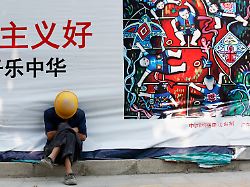Looming deflation
In China, there is a fear of falling prices
7/10/2023 5:29 p.m
Concern about a loss of purchasing power due to inflation is the dominant issue in many countries. In China, on the other hand, there are many signs of deflation – falling prices across the board – the consequences of which can be devastating.
As Western countries battle stubbornly high inflation, fears of deflation are growing in China. In June, Chinese manufacturers lowered their prices more than they had in seven and a half years due to weak demand. Producer prices fell by 5.4 percent compared to the same month last year, according to the statistics office in Beijing. This was not only the ninth decline in a row, but also the strongest since December 2015. Companies in the energy, metals and chemicals sectors in particular were forced to cut prices as demand at home and abroad weakened.
In addition, the inflation rate fell to zero in June. This means that consumer prices have already stopped rising – for the first time in almost two and a half years. They stagnated in June at the same month last year, after a slight increase of 0.2 percent in May. One reason might be the sluggish demand. According to analysts, this in turn increased the likelihood that the government and central bank could use new stimulus measures to boost demand.
In view of this data, the economists at the finance house Barclay spoke of a “difficult deflation environment”. Deflation is a broad-based fall in prices that can trigger a downward spiral of falling sales, wages and investment – with devastating consequences for the economy. Most economists consider deflation to be more dangerous for the development of an economy than slightly rising prices.
Currency and share prices fall
Concerns about deflation in China are also affecting the financial markets. The rate of the national currency, the yuan, fell, and Asian stocks also slipped into the red. “With credit demand weak and the currency under pressure, we think the bulk of the support will come from fiscal policy,” economists at Capital Economics expect. They expect the central bank to cut interest rates further this year. Analyst Hu Yuexiao from the financial house Shanghai Securities also assumes that the monetary authorities are likely to lower lending rates in order to boost demand.
China’s government is aiming for an average consumer inflation rate of around three percent this year. Last year, which was still heavily influenced by the restrictions resulting from the corona pandemic, the inflation rate was two percent. The central bank is currently facing the challenge of getting the country’s flagging economy back on its feet after the long phase of restrictive corona measures. However, the Chinese monetary authorities do not have the problem of the European Central Bank, which at the same time also has to fight against high inflation rates.
Falling real estate prices and the financial problems of numerous developers have not only dampened construction activity in China, but probably also consumer spending. The world export champion is also concerned that important sales markets such as Germany and the euro zone as a whole are in recession. Economists at major Western banks have recently lowered their forecasts for Chinese economic growth. According to forecasts by UBS, Standard Chartered, Bank of America and JPMorgan, the gross domestic product of the world’s second largest economy after the USA is likely to increase by between 5.2 and 5.7 percent this year. So far, the range has been 5.7 to 6.3 percent.
